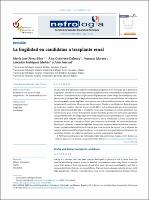| dc.contributor | Vall d'Hebron Barcelona Hospital Campus |
| dc.contributor.author | Pérez-Sáez, María José |
| dc.contributor.author | Gutiérrez-Dalmau, Álex |
| dc.contributor.author | Moreso Mateos, Francesc |
| dc.contributor.author | Rodríguez Mañas, Leocadio |
| dc.contributor.author | Pascual, Julio |
| dc.date.accessioned | 2022-01-24T14:17:01Z |
| dc.date.available | 2022-01-24T14:17:01Z |
| dc.date.copyright | 2020 |
| dc.date.issued | 2021-05 |
| dc.identifier.citation | Pérez-Sáez MJ, Gutiérrez-Dalmau Á, Moreso F, Rodríguez Mañas L, Pascual J. La fragilidad en candidatos a trasplante renal. Nefrologia. 2021 May;41(3):237–43. |
| dc.identifier.issn | 0211-6995 |
| dc.identifier.uri | https://hdl.handle.net/11351/6879 |
| dc.description | Candidate; Frailty; Kidney transplant |
| dc.description.abstract | Frailty is a concept that has been mainly developed in geriatrics and it came from the need of identifying subjects at risk to develop complications when they faced a stressful event. Frail patients have higher risk of mortality, poor outcomes and disability, and this is independent from their age or comorbidities. Chronic kidney disease patients present with high prevalence of frailty, especially those who are in renal replacement therapy. Frail or pre-frail patients on the kidney transplant waiting list represent 20-30%, and these patients are proven to have poorer results after the transplant, which is a stressful event itself. Tools for frailty assessment, both scales or indexes, may be usefulto identify which subjects might be at risk for complications after transplant, and this is necessary to adapt our clinical practice and minimize morbidity. The most used frailty scale in kidney patients is Fried scale, which is based in five phenotypic items. Besides that, knowing frail population allows potential interventions such as prehabilitation while the patient is waiting for the kidney transplant, which the aim of improving their vulnerability prior to transplant and, therefore, optimizing results after transplant. More studies are needed amongst kidney patients to improve and prevent frailty |
| dc.language.iso | spa |
| dc.publisher | Elsevier España |
| dc.relation.ispartofseries | Nefrología;41(3) |
| dc.rights | Attribution-NonCommercial-NoDerivatives 4.0 International |
| dc.rights.uri | http://creativecommons.org/licenses/by-nc-nd/4.0/ |
| dc.source | Scientia |
| dc.subject | Insuficiència renal crònica |
| dc.subject | Ronyons - Trasplantació - Complicacions |
| dc.subject | Astènia - Complicacions |
| dc.subject.mesh | Renal Insufficiency, Chronic |
| dc.subject.mesh | Kidney Transplantation |
| dc.subject.mesh | Frailty |
| dc.subject.mesh | /complications |
| dc.title | La fragilidad en candidatos a trasplante renal |
| dc.type | info:eu-repo/semantics/article |
| dc.identifier.doi | 10.1016/j.nefro.2020.09.004 |
| dc.subject.decs | insuficiencia renal crónica |
| dc.subject.decs | trasplante de riñón |
| dc.subject.decs | fragilidad |
| dc.subject.decs | /complicaciones |
| dc.relation.publishversion | https://doi.org/10.1016/j.nefro.2020.09.004 |
| dc.type.version | info:eu-repo/semantics/publishedVersion |
| dc.audience | Professionals |
| dc.contributor.organismes | Institut Català de la Salut |
| dc.contributor.authoraffiliation | [Pérez-Sáez MJ, Pascual J] Servicio de Nefrología, Hospital del Mar, Barcelona, Spain. [Gutiérrez-Dalmau Á] Servicio de Nefrología, Hospital Universitario Miguel Servet, Zaragoza, Spain. [Moreso F] Servicio de Nefrologia, Vall d’Hebron Hospital Universitari, Barcelona, Spain. [Rodríguez Mañas L] Servicio de Geriatría, Hospital Universitario de Getafe, Madrid, Spain |
| dc.identifier.pmid | 33339673 |
| dc.rights.accessrights | info:eu-repo/semantics/openAccess |

